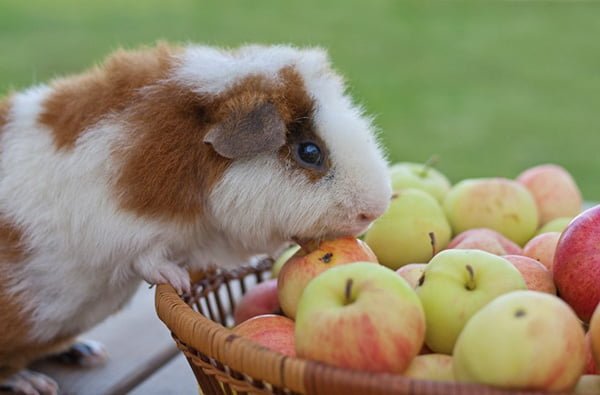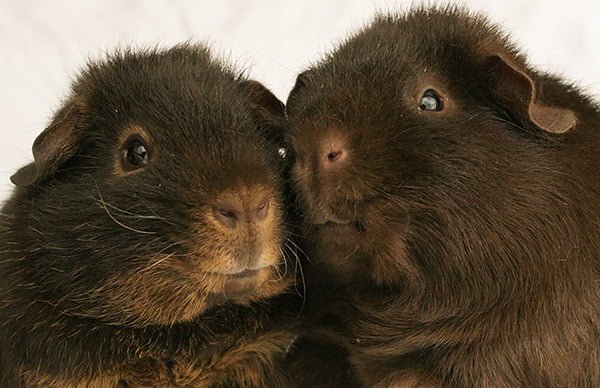Guinea pigs are lovable, personable pets that are just the perfect amount of independent and loving. These adorable creatures pack a lot of attitude and personality into a small, cuddly body and make great pets for children and adults alike.
One particular species of guinea pig is especially cute and friendly, the teddy guinea pig. This guinea pig is a bit friendlier and docile than other guinea pig species. Add to that the fact that it looks just like a tiny teddy bear, and how could it be cuter?
Is the teddy guinea pig breed the right next pet for you?
Name And Origin of Teddy Guinea Pigs
Guinea pigs, or Cavia porcellus, are large, tailless rodents native to several areas in South America but most particularly to the Andes. Domesticated guinea pigs come in various sub-breeds, colors, and fur textures. The teddy guinea pig is a breed that has short, coarse fur that gives this guinea pig the appearance of a teddy bear. They are also known as teddy bear guinea pigs, teddy cavy, and teddy bear cavy.
Size and Appearance
The teddy guinea pig is slightly smaller than the main species of the breed. Teddy guinea pigs grow to be about 10 to 12 inches long and can weigh anywhere from a pound and a half to three pounds. Unlike a Peruvian guinea pig, their coats come in a wide variety of colors but should consist of the trademark plush and coarse fur.
Life Expectancy of a Teddy Bear Guinea Pig
Healthy teddy guinea pigs live between 4 and 8 years.
Housing
Guinea pigs can be timid and shy creatures, and it is best to house your pigs away from other household pets or loud, distressing environments. Teddy guinea pigs should be housed in same-sex pairs or herds. In fact, it is often recommended that you always get at least two other guinea pigs, as the herding rodent will do much better with at least one same-species companion or with multiple guinea pigs.
Their enclosures should be large, and the more space you can give your teddy guinea pig, the better. A cage of one guinea pig should be at least 2.5 feet by 3 feet. The minimum space for two guinea pigs is 6-8 square feet, but it should be larger for every additional pig added to the herd. Teddy guinea pigs typically do not climb, so the walls only need to be about 14-18 inches tall to ensure they can't escape.
Wire walls work well for proper ventilation, but the base should be either solid or fleece, as wired bases can cause foot infections. Bedding should consist of either paper or fleece. Cedar and pine shavings are not recommended as they can cause respiratory issues in teddy guinea pigs.
Inside your piggy's enclosure, you should provide plenty of hideaway houses and items for your pig to chew on or play with.
Teddy guinea pigs also thrive with additional "playtime" outside their enclosure, either loose in a pet-proofed room or a large temporary run.
Behavior & Temperament
The teddy guinea pig is more friendly and docile than the main guinea pig breeds. These creatures spend their days eating, sleeping, and playing. They are active throughout the day but most active at dawn and dusk.
Teddy guinea pigs are social animals and will thrive in same-sex pairs or herds while also forming close bonds with their human owners. They enjoy human interaction and being held, cuddled, and petted. Teddy guinea pigs will need to be handled often when they are young to ensure they grow to be as comfortable with handling as possible, however. Teddy guinea pigs bite only when annoyed and need some time alone.
Guinea pigs have many vocalizations to communicate their needs and moods but are still generally quiet pets. They may squeal in the excitement in anticipation of food or play, and they also purr, rumble, and chatter.

Source: Flickr
Maintenance
Many first-time owners always wonder, do teddy guinea pigs smell? With regular cleaning and maintenance of the cage, the teddy guinea pig doesn't smell. A dirty enclosure will not only cause an unwanted pungent smell, but it can also create illness.
If your teddy guinea pig's cage is clean and has a stinking smell, check for any skin infection or signs of other health issues.
To prevent unwanted smell and illness, the cage should be cleaned weekly with spot cleaning daily. Spot cleaning includes removing soiled litter, bedding, and any uneaten small foods.
Deep cleaning of the cage should week done weekly. It's best to use warm water with a sponge and antibacterial spray. You can also use a blend of water and vinegar in a spray bottle.
Feeding
A teddy guinea pig's diet is plant-based and should mostly consist of a variety of grasses and hays, such as Timothy hay, orchard grass, and oat grass. You can supply this in a hay rack or box, and your teddy guinea pigs eat and graze on this all day and should have unlimited access to hay at all times.
To provide a well rounded and balanced diet to your teddy guinea pig, plain pelleted food should be supplemented. This food should not contain dyes, seeds, or nuts, just Timothy hay-based pellets. It is also advisable to get a pelleted diet that is fortified with a stabilized form of vitamin c. Vegetables can also be used to supplement a complete and healthy diet, though care should be given when offering your guinea pig fruit as this can lead to weight gain.
Offer a measured amount of pellets to your teddy bear guinea pig in a ceramic bowl once a day and throw out anything uneaten before refiling it the next day. Offer fresh veggies once or twice a day and remove anything uneaten within a few hours to avoid spoiling.
Water
All teddy bear pigs should have access to clean water at all times. Drip bottles are ideal as they are more sanitary and clean than water bowls. Never add anything to the water, even vitamin c supplement drops, as this can alter the flavor of the water and keep your guinea pig from drinking enough.
Grooming
Guinea pigs are naturally very clean animals, and the teddy bear guinea pig is no exception. These animals know how to keep themselves clean and will rarely need to be bathed. Only in the case of skin issues or a major mess will guinea pig owners ever need to bathe their teddy guinea pig.
Unlike the other guinea pig breeds, teddy guinea pigs don't need to be brushed constantly, and brushing once a week will be enough to get rid of loose hair.
While guinea pigs don't need bathing, they may benefit from an occasional brushing to get rid of loose hairs, especially during shedding season. Their nails need to be kept short so plan on trimming your teddy's nails every month or so.

Source: Pixabay
Gender Identification
Baby teddy guinea pigs can be very hard to gender correctly, so if you want to be sure you know what gender your teddy guinea pig is, be sure to check with a vet. As adults, female guinea pigs tend to be a little small and have pear-shaped bodies. Male guinea pigs, on the other hand, are usually larger and have bean-shaped bodies. Boys are often a bit more friendly than girls, but girls are generally a little less messy.
Common Health and Behavior Problems
Guinea pigs are prone to a number of health issues, the most common being—
Respiratory Issues
If you notice that your guinea pig is having difficulty breathing, it may have respiratory issues, and contact your veterinarian immediately. Depending on the type of respiratory disease, it may need antibiotics.
Scurvy
Guinea pigs cannot manufacture their own vitamin c. A deficiency of vitamin c can lead to scurvy which results in weakness, difficulty moving, and lethargy.
Bladder Stones
Also known as uroliths, it is common in middle-aged or older guinea pigs. Commonly accompanied by trouble urinating or blood in the urine.
It may be possible to flush small bladder stones out, but if the stone is too big, surgery may be the only solution.
Skin Parasites
The most common skin parasites are mites and lice. A guinea pig with a skin parasite will scratch excessively and super hair loss. These parasites are contagious and can carry through contaminated bedding.
If you suspect your guinea pig has skin parasites, contact your vet immediately to prevent infestation.
Dental Issues
Often a result of prolonged or untreated scurvy, dental issues occur when the teeth are overgrown, making eating difficult, resting in drooling, and weight loss.
Guinea pigs with dental issues are typically extremely interested in food but reluctant to eat. They may have difficulty chewing and swallowing and refuse to eat harder food.
For mild cases, dental issues can be addressed by increasing the amount of hay or grass.
Eye Infections
The most common eye issue in guinea pigs is pink eye, or conjunctivitis, which is very common in pet guinea pigs. It is generally caused by infection or hypovitaminosis.
If you suspect the guinea pig has an eye infection, contact your vet immediately, as it will need antibiotics to control the infection.
Bumblefoot
Bumblefoot is a common foot infection caused by wire cages or unsanitary floors. If it is found on a guinea pig's footpad, even mild cases can be excruciatingly painful for them.
If you suspect your pet has bumblefoot, seek a veterinarian immediately for treatments.
To prevent this infection, avoid using a wire bottom cage. Even though they make cleaning a breeze, there is a risk that comes with it.
